Estimated reading time: 14 minutes
Our Pioneer Ancestors Rendered Lard on a Regular Basis. Did They Know Something We Don’t?
A lot of people are quick to say “no” to lard as a cooking ingredient. That’s unfortunate. They certainly have their reasons, and some are well-founded, but lard isn’t the bad guy that many people make it out to be. Moderation is the key, and a well-timed fish fry or a deep-fried chicken dinner in lard will leave everyone smacking their lips. Let’s look at the facts.
Yes, lard is high in saturated fat, and saturated fats are high in LDL cholesterol (also known as “bad” cholesterol). But according to Harvard Health Publishing, trans fat is what you really need to worry about. You don't want to ingest a single gram of it.
Saturated fats, on the other hand, are all right in moderation. In fact, a meta-analysis of 21 studies was unable to find a significant link between saturated fat and heart disease. Doctors say you should still keep saturated fat at 10% of your calories or less just to be safe, but there is no reason to remove it altogether.
Want to save this post for later? Click Here to Pin It on Pinterest!
Lard: The Big Energy Booster
In my opinion, it's a good thing that lard is high in calories. It may seem odd to laud the benefits of calories from fat, but our bodies produce more internal heat from fat calories than from other types of calories. Our bodies also need fat for the proper functioning of many of our organs, including our brains. For the record, our brains are largely made of fat.
On the other hand, calories from carbohydrates offer a quick burst of energy and internal body heat but only for a short duration. In fact, it’s the high degree of carbohydrates in our diets that cause us to retain fat for the simple reason that it’s easier for our bodies to burn carbohydrates than fat.
This is why some of the high-fat/high-protein diets actually result in weight loss and cholesterol reduction. When we deny our bodies the easy luxury of carbohydrates like sugar and starches, we go into overdrive and burn the fat. That’s a good thing and that makes saturated fats less dangerous to health than some people assume. The telegram is simple: Enjoy the lard but skip the donut.
Lard: The Big Flavor Booster
Many people tout the flavor benefits of lard. Some people say it makes the best deep-fried chicken, is the perfect fat for a fish-fry, and adds a flavor to biscuits that a trans-fat like shortening can’t. In Belgium, French fries are traditionally deep fried in duck fat, but lard comes in a close second for the world’s best French fries.
Lard: The Money Saver
If you’re on a tight budget, skip the margarine and render the lard. It’s a great replacement for any recipe that calls for butter, shortening, or margarine and also saves you on the price of cooking oils. It makes a great pie crust and works with most any pastry recipe.
Raw Lard Sources
Finding raw lard for rendering can be a bit of a challenge. If you live in relatively close proximity to a pig farm, you’re in luck. They’ll often have an ample supply and it’s a low-cost commodity. Unfortunately, most of us don’t live close to a pig farm.
You would think butcher shops would have a good supply, but they either don’t have it or simply dispose of it because the low cost isn’t worth the effort of packaging or space in a refrigerator which can display higher margin meats.
Most grocery stores also present a dead-end, but there’s a solution at certain kinds of grocery stores. Look for the stores that appeal to a diverse and ethnic customer base. Many people from other countries and cultures aren’t averse to a coarse item like raw lard and appreciate its value as a flavor enhancer and calorie producer.
When you do find lard at an ethnic grocery store, it will typically be packaged with skin attached to the fat. You want that. The skin will surrender some lard during the rendering process and the skin can be further deep-fried to create some excellent pork rinds, usually referred to as cracklings. They’re not for everybody, but if you’ve never tried one, you’re missing the joy of a farm boy’s potato chip.
Lard Rendering Tools
These tools are tied to the process steps for rendering lard. They include:
- Kitchen shears which do a better job of cutting through the pork fat and skin than even the sharpest knife, and a cutting board to protect any countertop from the cutting process.
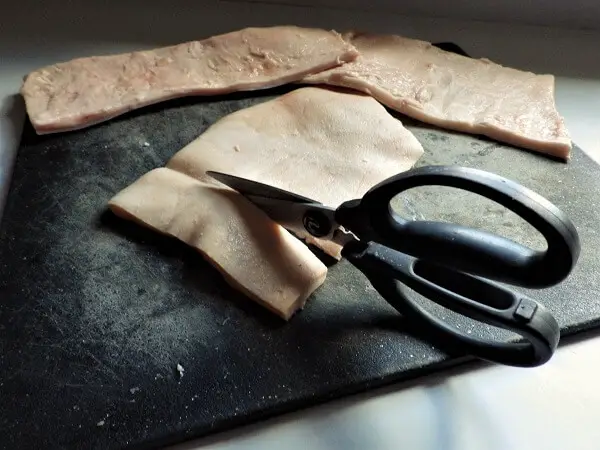
- A 7-quart crockpot or larger slow cooker to render the lard at a low temperature for a long period of time (24 to 72 hours or more depending on the quantity you are rendering).
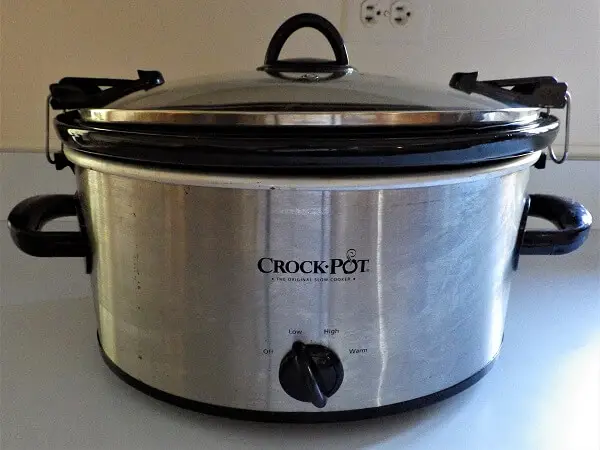
- A large, metal slotted spoon for stirring the lard while it renders and to remove bits of skin as you go, and a large, metal ladle for collecting and pouring the lard into jars.
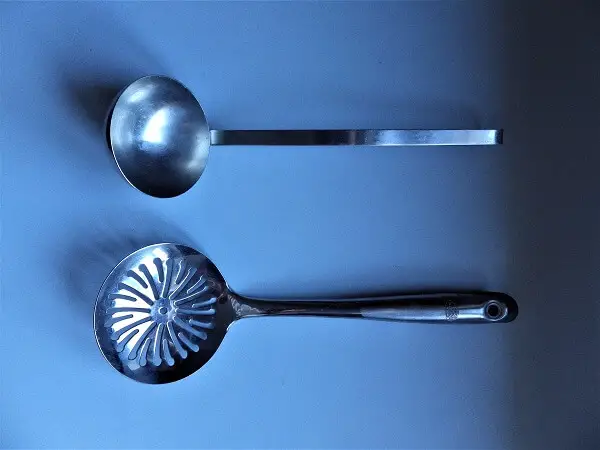
- Sufficient canning jars, either one quart or one pint in size, plus lids. You can use smaller jars if you want a smaller, meal-size portion.
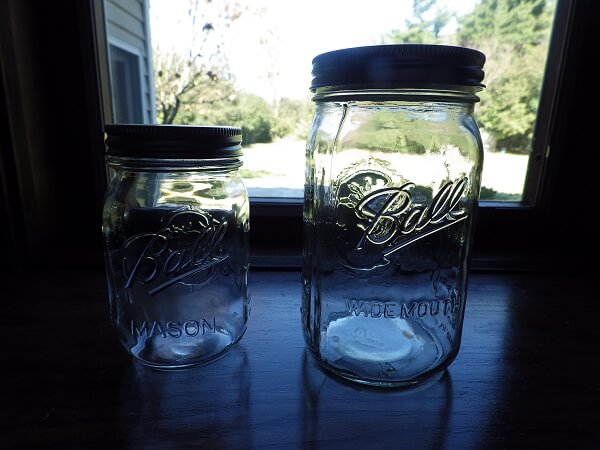
- A canning funnel to prevent the lard from dripping onto the sides of the jars or rim and Mason jar tongs for lifting the hots jars from the hot water bath.
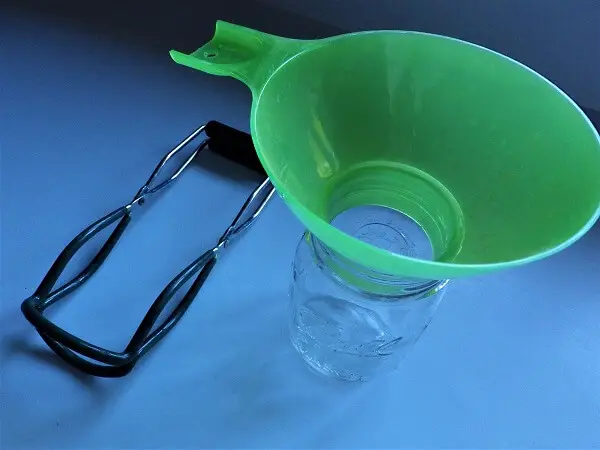
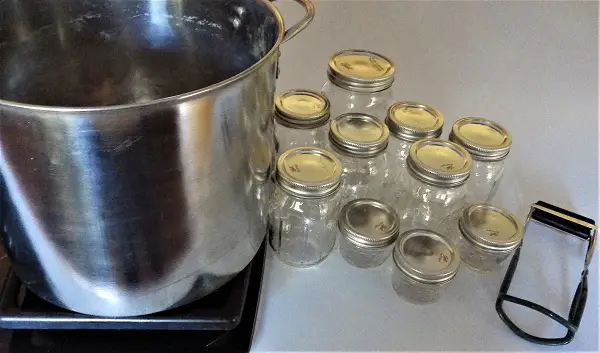
- A large, clean towel for draining and drying the sterilized jars, along with dry washcloths or paper towels to occasionally clean and dry your hands after handling a lot of raw fat.

- And don’t forget the raw lard.
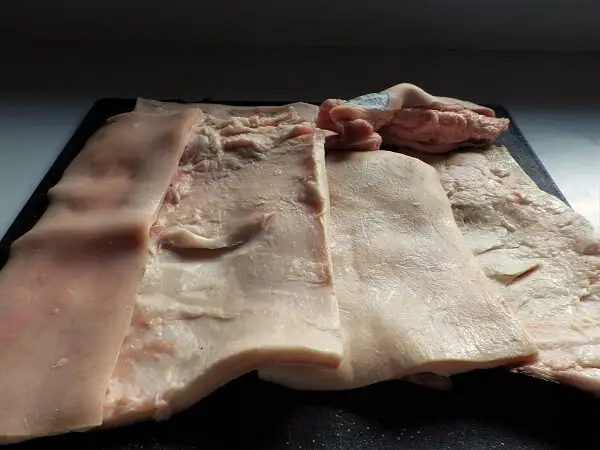
If you’re not using a crockpot, you can use a large stockpot over hot coals outside. A wood fire in a kettle grill burned down to coals is a good option.
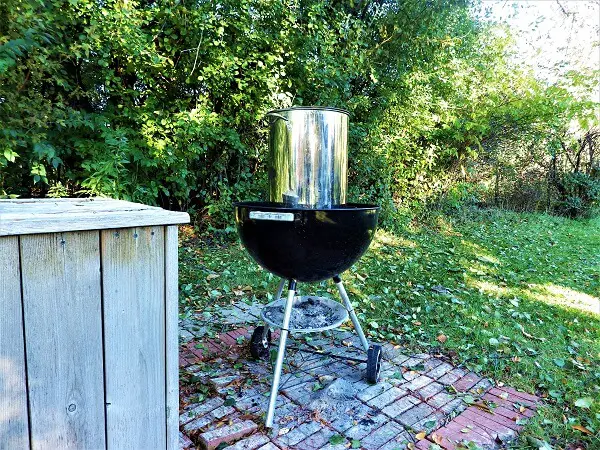
Make sure you have a deep and large stock pot and don’t overfill it with raw lard. 2/3 full is the limit. A grease fire over open coals is serious stuff.
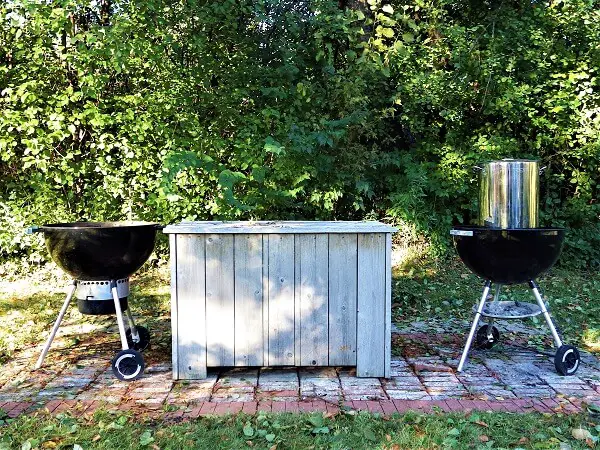
Go low and slow and burn your wood to coals in a separate area and transfer the coals under the pot with a shovel as you go. A second kettle grill could serve as your burning pit to keep you supplied with hot coals.
Kettle grills are a good option for outdoor lard rendering because it’s easier to manage the coals and the heat. You may need to tend the hot coal fire under the stock pot in the middle of the night to keep the heat going. If it cools down substantially, you may attract various animals who can’t resist the aroma of pork fat in the wind.
And here’s a big fat tip. Pork fat can be soft, loose, and very greasy. To firm it up and make your cutting job easier, freeze the thawed pork skins for 10 to 15 minutes to give it a bit more resistance to the edges of your kitchen shears.
Rendering The Lard
- Use kitchen shears to cut the pork skins into pieces around 1-inch square with the fat still attached.
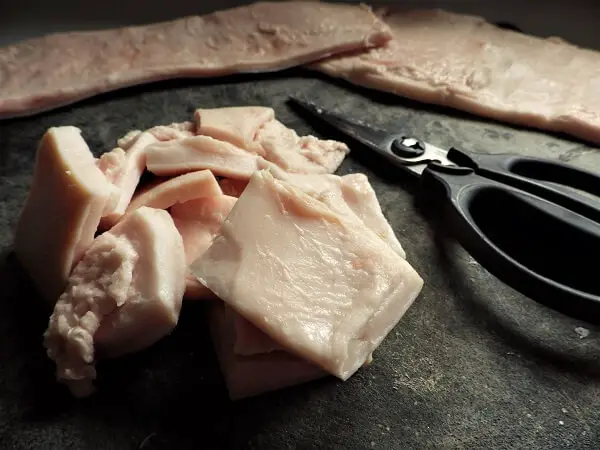
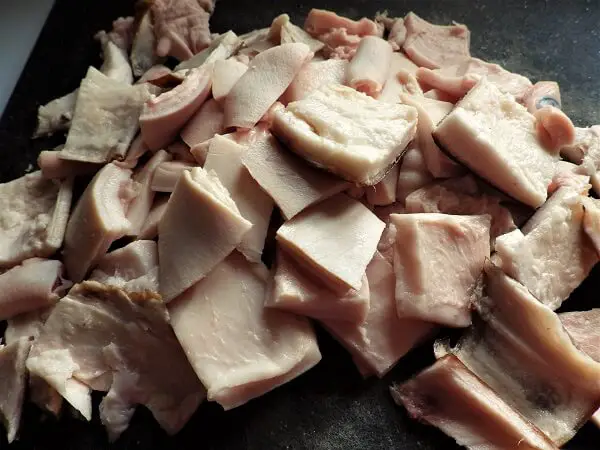
- Fill a 7-quart crockpot ¾ full of the pork fat chunks and set the heat for low. Take the time to put the first layer into the crockpot fat side down.

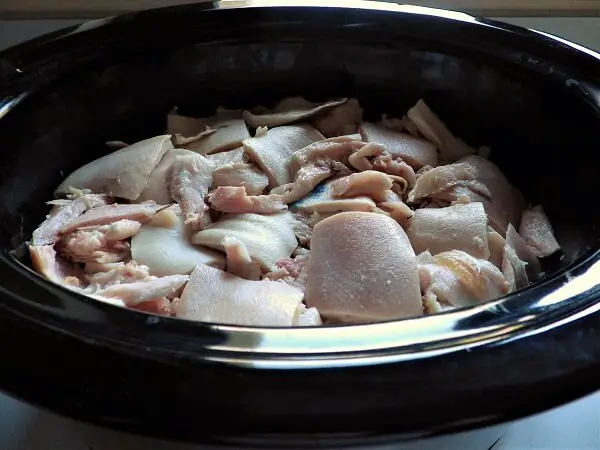
- If you want, you can start on high until the rendering lard starts to bubble and then turn the crockpot to low.

- Keep the pot covered while the lard renders. Bubbles can and will splatter grease.
- As the lard renders it will assume a clear and light brown translucency.
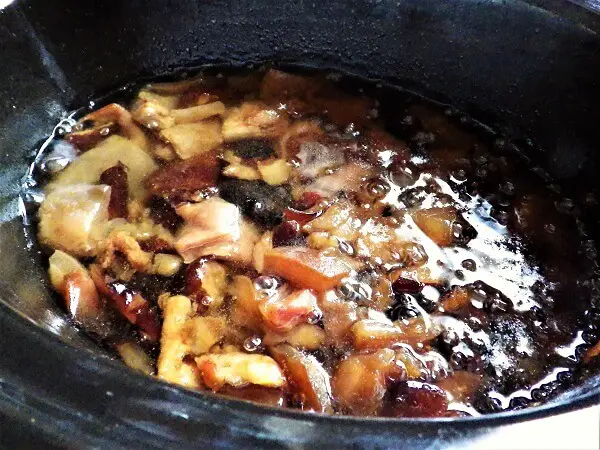
- While the lard is rendering, it’s time to sterilize the jars. Add enough water to a large pot to cover the canning jars you are planning to use. Toss the lids into the pot with the jars and boil uncovered for 10-minutes.
- Stir the crockpot of lard chunks gently with the slotted spoon from time to time to allow each piece to be exposed to the heat of the lard for further rendering.
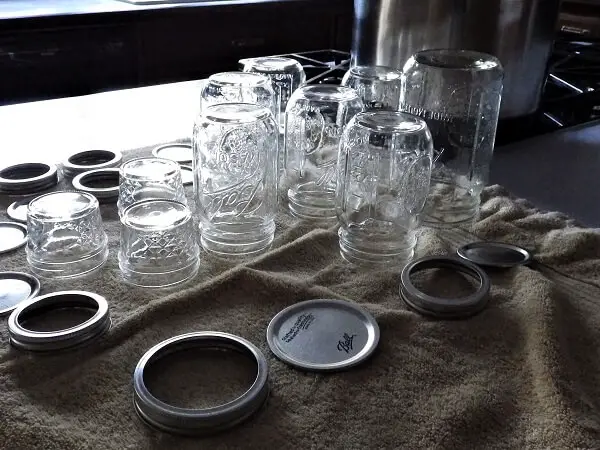
- Carefully remove the sterilized jars from the hot-water-bath with jar lifting tongs and allow to dry on a clean, dry towel with the open ends down.

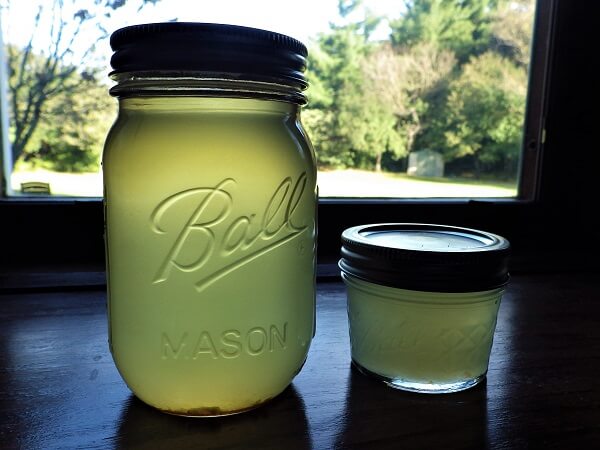
- When it appears that sufficient lard has rendered to fill a jar, carefully ladle it into a sterilized jar using the canning funnel to prevent drips. You don’t want any drips on the rims because that can compromise the seal of the lid. You may need one of your dry washcloths to protect your hands from the heat of the jar while you screw on the lid.
(If you are rendering over open, hot coals outdoors, remove the pot from the coals to some distance before ladling into a jar so that any drips don’t catch fire and ignite the lard in the pot).
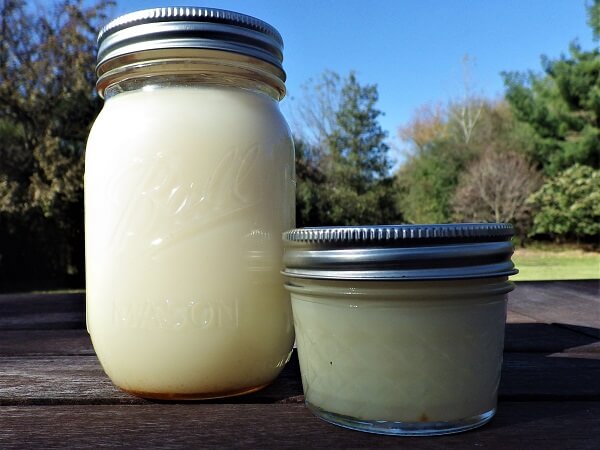
- Allow the jars to rest for 12 to 24 hours at room temperature. You can accelerate the process by refrigerating the jars. The translucent fat will solidify into a bright white.
Storing Your Lard
Canning
Lard can be stored up to 5 years if canned properly in sterilized jars, is unopened and stored in a cool, dark place like a dark pantry, basement, or root cellar. Whenever you open a stored jar of lard, smell the lard first. If it has an off color, odor, or a mildew smell, discard it. A refrigerator is an ideal choice, but lard must be refrigerated after opening and used within a month.
Freezing
You can also freeze your lard. A simple way to do this is with ice cube trays. Simply pour the lard directly into an ice cube tray, let it set up at room temperature, freeze, and then place the cubes into a resealable, plastic bag. This is a great way to manage portion control. There are two tablespoons in the average ice cube, so you can easily determine the proper portion for any recipe. Better yet, partially thawed ice cubes can be cut up into slices and make the perfect addition for making a pie crust.
Can I Recycle Lard?
It’s not recommended to try and recycle lard that has been used for deep frying unless you filter it extremely well. This would include filtering through a mesh filter and either a layer of cheesecloth or even a coffee filter to remove any particulate matter floating in the yard after frying.
Most restaurants filter their oils and fats and re-use them, but their equipment and process are highly specialized. Lard is easily contaminated by anything that was deep fried. Once you’re done with the chicken frying or fish fry, either filter carefully before reuse or dispose of the used lard.
Now That You Know the Facts and the Fats, Give Lard Rendering a Try
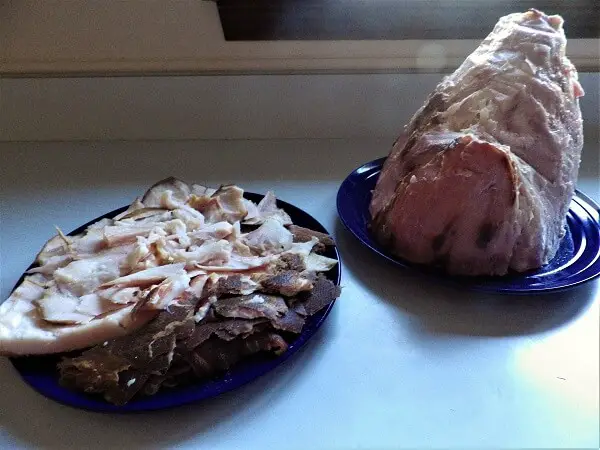
If you want to try a low-impact approach to lard rendering, you can remove the fat from a shank or butt portion of ham and cut it into chunks and render it in your crockpot. You won’t get a lot of lard but enough to see what a difference the flavor of lard can make for anything you bake or fry.
Who knows, you may like it enough to search out that ethnic grocery store and really roll up your sleeves and surrender to the render.
Like this post? Don't Forget to Pin It on Pinterest!


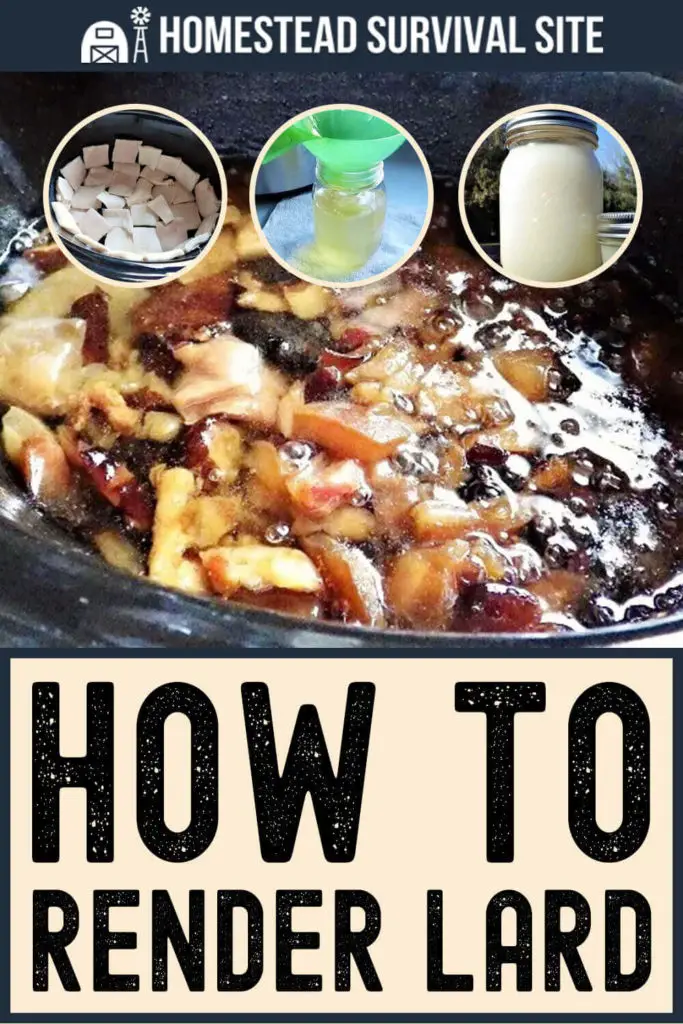

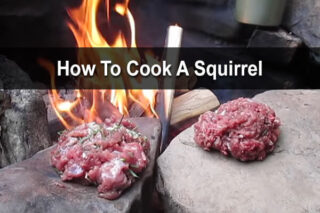

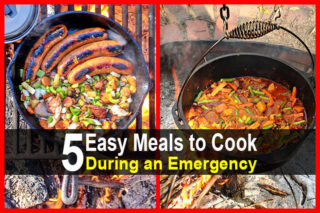
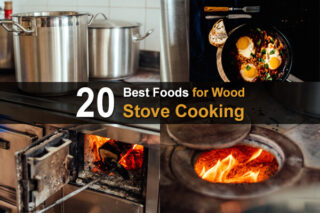
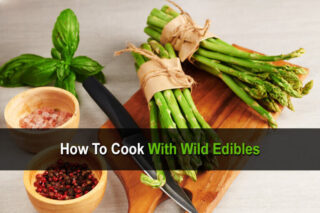


Lard is a awesome product. We use it here in the south a lot. It can be bought in 5gallon buckets in most grocery stores in my area. There is nothing like lard for flavor in sothern cooking. I always keep a jar or two of lard or bacon grease in the fridge for seasoning of greens, vegetables and biscuits. Nothing compares to the flavor and texture in pastries, like lard. It has so many uses, for cooking and on the farm. We even use it to make lamp oil for emergency use. It may have a bad reputation for your diet, but everything in moderation. I will always use lard over cooking oils, it’s just the way I was raised. Kind of like butter over margarine. Butter wins every time.
Well Bless Your Heart. I am SE Louisiana and love lard ( bacon ) seasoning.
My food would always win over.
Yes these health nuts that will not eat lard or fatty foods, just don’t know what they are missing. Lard and bacon grease are a vital part of life in the south. It just brings any food from good to great and makes your taste buds rejoice with joy. It’s not the healthiest item on the menu, but everything in moderation. It’s what makes soulfood taste so good, it’s what brings you back to dinner at your grandmother’s house. Its an unforgettable flavor you will always search out once you’ve tried it. There is no substitute for lard or bacon grease. At least not in the south. It gives you a warm feeling of love and always makes good food better. Plus it has many other uses around the house, like making candles, the flakyest pie crusts and most tender biscuits one can have. Always save your bacon grease in jars put up in the fridge. Label them when you put them in the fridge, and use the oldest ones first. I promise you it will add a flavor to vegetables you will never forget. It’s the soul in soulfood. Along with the human making the dish.
What kind of ‘ethnic’ grocery store? Do you mean Asian or some other?
I think he just means any type of grocery store that sells food you’d normally find in other countries.
You don’t have to get it from an ethnic grocery store. Ask the meat butcher or people in the meat department of any grocery store. They should have it in 5gallon buckets, about $10-$25. They use it for making sausage and deli meats. If you have a piggly wiggly grocery store They carry it. So does any butchers shop that make their own sausage.you can usually get it from any grocery store. Look for it in the aisle where they have Crisco grease or solid shortening. You can render the grease from bacon pieces or trimmings. They usually sell it in bulk boxes of 40#’s. Put it in a deep dish baking pan, and in the oven at 350degrees, have sterile jars ready, as the grease turns into a liquid,, pour it in the jars slowly the jars will get extremely hot very quick, wipe the lip of the jar and put on a lid and band, tighten finger tight. The grease being so hot it should seal the jars as they cool down. Listen for the pop of the lid on the jar. This means that it sealed. When cool to the touch, put in the fridge the lid will not move or pop up and down. The lid should be sunken down just a little and when pressed on should not move or pop. ntry. If sealed properly they should store about a year. Although they probably won’t last that long, as you will use it in almost every dish you make. The addition of the grease into any vegetable dish is devine. You can store the bacon pieces in jars also, or in tupperware containers in the freezer. If you choose to store the bacon in jars, you need to use the hot water canning method to make sure that you get a good seal on the jars. Then store them in the pantry when cooled. When canning listen for the pop of the lid and check that they are sealed with the lid down and pushing on the lid there
OR—buy a pint jar on Amazon! It’s not cheap: about $16 for a pint jar, which might be a good motive to DIY.
Thank you for the step by step guide. My family and I enjoy cooking with a variety of fats/oils. I’ve have even given rendering bacon grease for making homemade soap and was wondering if I could make lard. Now, I know I can. Thank you. And as to the stores that sell Lard; usually if the store has an isle for Baking/Oils or Mexican/Spanish/Creole seasonings and foods, then they generally have Lard. I would just ask, lots of store managers generally do not mind ordering a special request. Just make sure you leave them your contact information and check back with them, so they do not forget.
Glad you found the guide helpful! And yea, it’s best to just ask store managers. The worst they can do is say no.
Be careful when you consider buying lard at the grocery store. Read the ingredient list. If it has been Hydrogenated; don’t buy it. Trans fats arecreated when it gets hydrogenated. Look for a jar of Organic lard.
If possible; Use LEAF lard for baking . It has a more delicate flavor than hide lard. leaf lard is found near the pig’s kidneys.
Walmart sells organic lard
If you want to reuse lard, place a number of potato slices in the lard, when you finish cooking. Turn the heat off and let it sit until cool. You can either eat the potato slices or throw them out. The potato will pull the after taste, of whatever you cooked, out of the grease. The lard that you buy at a store has an additive added to make it a solid, at room temperature . If you want pure lard it will be in the dairy case. it is not a solid at normal temperature.
There are comments listed regarding doing a hot water bath as a method of canning lard. Can someone give me some hints as to the time needed to bathe the jars and if there are any problems doing this (e.g. jars blowing up while in the bath…)? Thanks. Don
Glad you recycle these articles now and then, I never saw this one before, and it is clearly from several years back.
When I spent a few years on a farm, we’d make some bacon in a fry pan each morning, and leave some of the grease in the pan. It’s what we then fried the eggs in! Best eggs ever.
Thanks for letting me remember and learn.
Now you can even buy it in our stores in the south